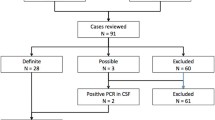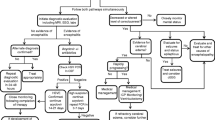Summary
A total of 208 patients underwent brain biopsy for presumptive herpes simplex encephalitis and were randomized to receive either vidarabine, vira-A, at 15 mg/kg/day, or acyclovir, at 30 mg/kg/day for ten days. 69 patients (33%) had biopsy-proven disease; 37 received vira-A and 32 acyclovir. With the exception of age, patient populations were balanced for demographic characteristics. Overall survival for acyclovir recipients was 72% compared with 46% for vira-A-treated patients 18 months after therapy (p=0.008). After adjustment for differences of age between treatment populations by multivariant regression analyses, acyclovir treatment remained superior to vidarabine therapy (p=0.041). Mortality varied according to the level of consciousness at the onset of therapy. For lethargic, semicomatose and comatose patients, mortality was 42%, 46%, and 67%, respectively, for the vira-A-treated patients and 0%, 25% and 25%, respectively, for acyclovir-treated patients. Six months post-therapy morbidity assessments revealed five (14%) vira-A versus 12 (38%) acyclovir recipients who had returned to normal function, while eight (22%) and three (9%), respectively, had moderate debility. Outcome differences were significant (p=0.02; Wilcoxon, 2-sample test) using an adapted scoring system. Age and Glasgow coma scale > 10 predicted the best outcome following acyclovir treatment. Disoriented patients who flex and respond by eye to pain had no mortality and 50% returned to normal. These data indicate that acyclovir is the treatment of choice for biopsy-proven herpes simplex encephalitis.
Zusammenfassung
Bei 208 Patienten wurde wegen Verdachts auf Herpes simplex-Enzephalitis eine Gehirnbiopsie durchgeführt. Nach Randomisierung wurde entweder mit Vidarabin in einer Dosierung von 15 mg/kg pro Tag oder mit 30 mg/kg/Tag Aciclovir für zehn Tage behandelt. Bei 69 der biopsierten Patienten (33%) wurde die Diagnose bestätigt, von ihnen erhielten 37 Vidarabin und 32 Aciclovir. Die demographischen Charakteristika der beiden Gruppen waren mit Ausnahme des Alters vergleichbar. 18 Monate nach der Therapie waren 72% der mit Aciclovir behandelten und 46% der mit Vidarabin behandelten Patienten am Leben (p=0,008). Nach Ausgleich der Altersunterschiede in den beiden Patientengruppen mittels Multivarianten-Regressionsanalyse blieb Aciclovir gegenüber Vidarabin immer noch therapeutisch überlegen (p=0,041). Je nach Grad der Bewußtseinsstörung zu Beginn der Therapie war die Sterblichkeit unterschiedlich hoch. Die Letalität nahm von Lethargie zu Semikoma und Koma von 42% auf 46% und 67% bei mit Vidarabin und von 0% auf 25% und 25% bei mit Aciclovir behandelten Patienten zu. Nachuntersuchungen bezüglich Restschäden sechs Monate nach Therapie ergaben bei fünf mit Vidarabin (14%) und 12 mit Aciclovir (38%) behandelten Patienten eine vollkommene Wiederherstellung und bei acht (22%) bzw. drei (9%) eine mäßiggradige zerebrale Funktionseinschränkung. Die Unterschiede der Therapieergebnisse erwiesen sich bei Anwendung eines angepaßten Punktesystems als signifikant mit p=0,02 (Zwei-Proben-Test nach Wilcoxon). Bei einer Punktezahl von mehr als 10 im Glasgow Koma-Schema war das Ergebnis nach Aciclovir-Behandlung am günstigsten. Bei bewußtseinsgestörten Patienten mit erhaltenen Reflexen und Augenreaktionen auf Schmerzreiz traten keine Todesfälle auf, 50% der Patienten wurden völlig wiederhergestellt. Aufgrund dieser Daten ist Aciclovir als Therapie der Wahl bei bioptisch gesicherter Herpes simplex-Enzephalitis anzusehen.
Similar content being viewed by others
Literature
Nolan, D. C., Carruthers, M. M., Lerner, A. M. Herpesvirus hominis encephalitis in Michigan: report of thirteen cases, including six treated with idoxuridine. N. Engl. J. Med. 282 (1970) 10–13.
Lerner, A. M., Bailey, E. J. Concentrations of idoxuridine in serum, urine, and cerebrospinal fluid of patients with suspected diagnosis of herpesvirus hominis encephalitis. J. Clin. Invest. 51 (1973) 45–49.
Boston Interhospital Virus Study Group and the NIAID Cooperative Antiviral Clinical Study Failure of high dose 5-iodo-2′-deoxyuridine in the therapy of herpes simplex virus encephalitis. N. Engl. J. Med. 292 (1975) 600–603.
Whitley, R. J., Soong, S. J., Dolin, R., Galasso, G. J., Alford, C. A., the Collaborative Study Group Adenine arabinoside therapy of biopsy-proved herpes simplex encephalitis. N. Engl. J. Med. 297 (1977) 289–294.
Whitley, R. J., Soong, S. J., Hirsch, M. S., Karchmer, A. W., Dolin, R., Galasso, G., Dunnick, J. K., Alford, C. A., the NIAID Collaborative Antiviral Study Group Herpes simplex encephalitis. Vidarabine therapy and diagnostic problems. N. Engl. J. Med. 304 (1981) 313–318.
Elion, G. B., Furman, P. A., Fyfe, J. A., deMiranda, P., Beauchamp, L., Schaeffer, H. J. Selectivity of action of an antiherpetic agent, 9-(2-hydroxyethoxymethyl) guanine. Proc. Natl. Acad. Sci. USA 74 (1977) 5716.
deMiranda, P., Whitley, R. J., Blum, M. R., Keeney, R. E., Barton, N., Cocchetto, D. M., Good, S., Hemstreet, G. P., Kirk, L. E., Page, D. A., Elion, G. B. Acyclovir kinetics after intravenous infusion. Clin. Pharmacol. Ther. 26 (1979) 718–728.
Whitley, R. J., Alford, C. A. Hirsch, M. S., Schooley, R. T., Luby, J. P., Aoki, F. Y., Hanley, D., Nahmias, A. J., the NIAID Collaborative Antiviral Study Group Herpes simplex encephalitis: adenine arabinoside versus acyclovir therapy. N. Engl. J. Med. 314 (1986) 144–149.
Jennett, B., Teasdale, G., Braakman, R., Minderhoud, J., Heiden, J., Kurze, T. Prognosis of patients with severe head injury. Neurosurgery 4 (1979) 283–289.
Coleman, R. M., Nahmias, A. J., Williams, S. C., Phillips, D. J., Black, C. M., Reimer, C. B. IgG subclass antibody to herpes simplex virus. J. Infect. Dis. 151 (1985) 929–936.
Pereira, L., Klassen, T., Baringer, J. R. Type-common and type-specific monoclonal antibody to herpes simplex virus type 1. Infect. Immun. 29 (1980) 724–734.
Burdette, W. J., Gehan, E. A. Planning and analysis of clinical studies. In:Thomas, C. C. (ed. Springfield, Illinois, 1970, pp. 72–77.
Cox, D. R. Regression models and life-tables. J. R. Statist. Soc. 34 (1972) 187–220.
Sköldenberg, B., Forsgren, M., Allestig, K., Bergstrom, T., Burman, L., Dahlqvist, E., Forkman, A., Fryden, A., Lovgren, K., Norlin, K., Norrby, R., Olding-Stenkvist, E., Stiernstedt, G., Uhnoo, I., de Vahl, K. Acyclovir versus vidarabine in herpes simplex encephalitis. Randomized multicenter study in consecutive Swedish patients. Lancet I, 8405 (1984) 707–711.
Author information
Authors and Affiliations
Consortia
Additional information
Members of the NIAID Collaborative Antiviral Study Group include:M. Myers (Projects Officer), NIAID, NIH;R. Whitley, C. Alford, S. Soong, G. Caddell, C. G. Cobbs, J. Gnann, R. Morawetz, J. W. Benton, O. Snead, Central Unit, University of Alabama at Birmingham;M. S. Hirsch, R. T. Schooley, Massachusetts General Hospital, Boston;R. Dolin, R. Betts, R. Reichman, University of Rochester;L. Corey, University of Washington;F. Aoki, A. W. Hammond, University of Manitoba, Winnipeg;M. Levin, R. Andersen, University of Colorado;A. Nahmias, H. Keyserling, S. Schwartzmann, Emory University, Atlanta;J. Wolinsky, University of Texas-Houston;D. Hanley, The Johns Hopkins University;J. Connor, S. Spector, M. Oxman, D. Richamn, University of California, San Diego;F. Hayden, J. Greenlee, University of Virginia;S. Greenberg, L. Taber, Baylor University, Houston;J. Luby, University of Texas Health Science Center at Dallas-Southwestern Medical School;M. Myers, C. Linnemann, University of Cincinnati;D. Powell, Ohio State University, Columbus;D. Durak, Duke University;R. Pollard, University of Texas, Galveston;J. Joncas, St. Justine's Hospital,G. Albert, Hospital du Sacre-Coeur, Montreal;A. Arvin, A. Yeager †, Stanford University;P. Wright, C. Edwards, Vanderbilt University;T. J. Marrie, Dalhousie University, Halifax;H. Balfour, University; of Minnesota,M. Marks, V. San Joaquin, University of Oklahoma;L. Frenkel, New Jersey College of Medicine and Dentistry;M. Kleiman, K. Fife, University of Indiana;K. Liu, D. Hinthorn, University of Kansas;S. Starr, S. Plotkin, University of Pennsylvania,G. Pazin, M. Ho, University of Pittsburgh;C. Summaya, University of Texas, San Antonio;R. Baringer, University of Utah;Y. Bryson, University of California, Los Angeles;M. Cohen, S. Lemon, University of North Carolina at Chapel Hill;A. Chow, University of British Columbia, Vancouver;R. Haynes, Wright State University, Dayton;M. Weil, Harbor-UCLA Medical Center, Torrance;A. W. Karchmer, S. Hamner, New England Deaconess Hospital, Boston;J. Tilles, University of California, Irvine;R. Buchanan, E. Marcus, S. Thornton, E. Thibodeau, Parke-Davis Company, Ann Arbor, Michigan;D. Barry, D. King, R. Keeney, R. Clemons, Burroughs Wellcome Company, Research Triangle Park, North Carolina.
Rights and permissions
About this article
Cite this article
Whitley, R.J., Alford, C.A., Hirsch, M.S. et al. Factors indicative of outcome in a comparative trial of acyclovir and vidarabine for biopsy-proven herpes simplex encephalitis. Infection 15 (Suppl 1), S3–S8 (1987). https://doi.org/10.1007/BF01650104
Issue Date:
DOI: https://doi.org/10.1007/BF01650104




